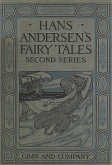The teapot
Fairy tale by Hans Christian Andersen
There was once a proud teapot; it was proud of being porcelain, proud of its long spout, proud of its broad handle. It had something before and behind,—the spout before and the handle behind,—and that was what it talked about. But it did not talk of its lid, which was cracked and riveted; these were defects, and one does not talk of one's defects, for there are plenty of others to do that. The cups, the cream pot, and the sugar bowl, the whole tea service, would think much oftener of the lid's imperfections—and talk about them—than of the sound handle and the remarkable spout. The teapot knew it.
"I know you," it said within itself. "I know, too, my imperfection, and I am well aware that in that very thing is seen my humility, my modesty. Imperfections we all have, but we also have compensations. The cups have a handle, the sugar bowl a lid; I have both, and one thing besides, in front, which they can never have. I have a spout, and that makes me the queen of the tea table. I spread abroad a blessing on thirsting mankind, for in me the Chinese leaves are brewed in the boiling, tasteless water."
All this said the teapot in its fresh young life. It stood on the table that was spread for tea; it was lifted by a very delicate hand, but the delicate hand was awkward. The teapot fell, the spout snapped off, and the handle snapped off. The lid was no worse to speak of; the worst had been spoken of that.
The teapot lay in a swoon on the floor, while the boiling water ran out of it. It was a horrid shame, but the worst was that everybody jeered at it; they jeered at the teapot and not at the awkward hand.
"I never shall forget that experience," said the teapot, when it afterward talked of its life. "I was called an invalid, and placed in a corner, and the next day was given to a woman who begged for victuals. I fell into poverty, and stood dumb both outside and in. But then, just as I was, began my better life. One can be one thing and still become quite another.
"Earth was placed in me. For a teapot, this is the same as being buried, but in the earth was placed a flower bulb. Who placed it there, who gave it, I know not; but given it was, and it became a compensation for the Chinese leaves and the boiling water, a compensation for the broken handle and spout.
"And the bulb lay in the earth, the bulb lay in me; it became my heart, my living heart, such as I had never before possessed. There was life in me, power and might. The heart pulsed, and the bulb put forth sprouts; it was the springing up of thoughts and feelings which burst forth into flower.
"I saw it, I bore it, I forgot myself in its delight. Blessed is it to forget oneself in another. The flower gave me no thanks; it did not think of me. It was admired and praised, and I was glad at that. How happy it must have been! One day I heard some one say that the flower deserved a better pot. I was thumped hard on my back, which was a great affliction, and the flower was put into a better pot. I was thrown out into the yard, where I lie as an old potsherd. But I have the memory, and that I can never lose."
Hans Andersen's Fairy Tales Second Series

Notes: This is the second volume of Andersen's fairy tales edited by J. H. Stickney.
Author: Hans Christian Andersen
Editor: J. H. Stickney
Published: 1915
Publisher: Ginn and Company - Boston; New York; Chicago; London